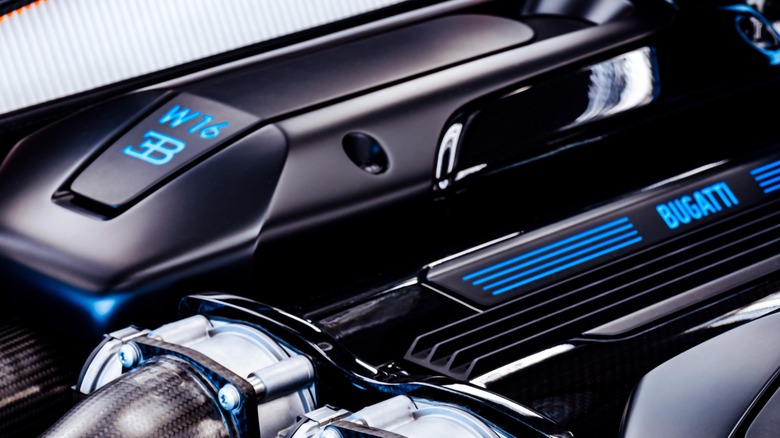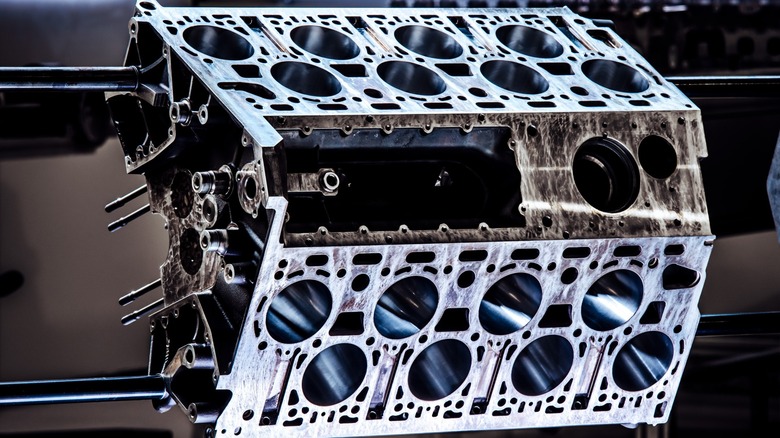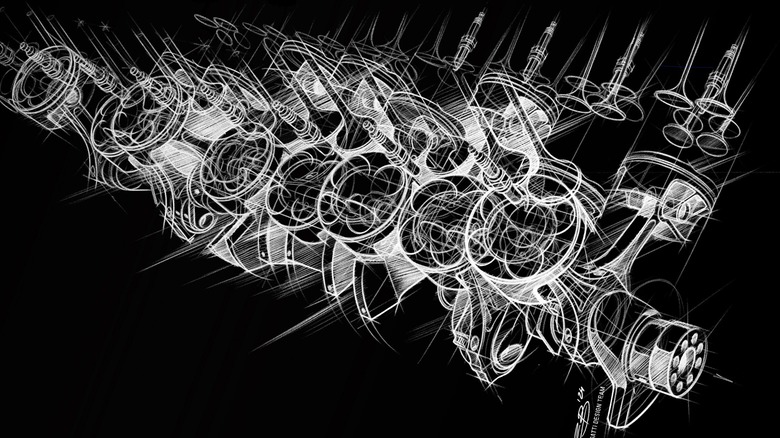W16 Vs. V16 Engines: What's The Difference?
The world of internal combustion engines holds a number of engine types and designations. Listening to a discussion between a group of motorized transportation enthusiasts (gearheads) likely sounds like some sort of code to the uninitiated without knowing the meaning of terms like HEMI, VTEC, and NISMO. Even the engine's base form is confusing with common designations like V-Twin, inline-four, straight-six, V6, and V8. Throw in V16 and the weirder-sounding W16 and it almost becomes a foreign language. We'll do our best to explain the W16 and V16.
You might think that engines as large and complicated as those containing 16 cylinders are a modern invention. However, a V16 in the 1930 Series 452 ranks as one of Cadillac's most ambitious and iconic engines. The W16 engine's roots go back to a 1916 rotary valve W16 design credited to Gaston Mougeotte of France.
While both engine designs date back to the early 1900s, modern versions capitalize on modern technology such as hybrid drivetrains and sequential turbochargers to deliver enormous power. As automakers strive to create more efficient, compact, and powerful cars, which engine design will move forward into the next quarter century?
The W16 engine layout explained
Internal combustion engines make power by igniting a compressed air-fuel mixture inside its cylinders. While there is a point of diminishing returns related to cylinder size and number, more is often better, and 16 cylinders still deliver acceptable power-to-weight ratios for at least one automaker.
The question then becomes, what is the most efficient way to organize the cylinders? An inline 16-cylinder engine would require a long engine block. Imagine placing 16 apples in a line; this layout is not particularly suitable for use in an automobile where a more compact arrangement is preferable.
One way to visualize the compact W16 layout is laying four of those 16 apples in a line pointing away from you. Next, snuggle three more in the notches created at each apple junction, then add the eighth apple at the end of the line of three. Finally, create another similar grouping with the remaining eight apples a few inches to the right or left of the first group. If you look at the pattern, you can see W shapes formed by the cylinders. The Bugatti W16 uses a single crankshaft with the centerline of each cylinder bank separated by 90 degrees.
Bugatti is the only modern automaker to utilize the unusual W16 engine design, and potentially the last as the W16's replacement is already in production. Over the past two decades the Bugatti 8.0L W16 has powered some of the world's most exotic hyper sports cars. With forced air induction provided by four, two-stage turbochargers, Bugatti's W16 produces upward of 1,578 horsepower (1,600 PS) and 1,180 lb-ft of torque (1,600 Nm).
How is a V16 engine different from a W16?
As the name implies, a V16 engine has two parallel banks of eight cylinders laid out in a V formation. Over the years, automakers have applied various angles to the V to provide more or less separation between the cylinder banks. The 1938 Cadillac V16 had a 135-degree angle, making it nearly flat, while the new hybrid Bugatti Tourbillon's V16 is laid out on a 90-degree V. However, most V16 engine designers use 45-degree layouts for improved engine balancing, as evidenced using the math formula provided by Car and Driver.
Another difference between W16 and V16 engines is that the W is no longer in production while the V lives on. In recent years automakers other than Bugatti, both would-be and established, have attempted modern versions of the V16. Models such as the insane 5,000-hp Devel Sixteen, the Cadillac Sixteen, and Rolls-Royce 100EX Convertible never made it past the concept stage.
The 8.3L V16 engine in the new Bugatti Tourbillon makes 1,000 horsepower (1013.9 PS) on its own before the additional power of the hybrid powertrain. While not as much as the outgoing quad-turbo 8.0L W16, the V16 accomplishes that power rating without forced air induction.


